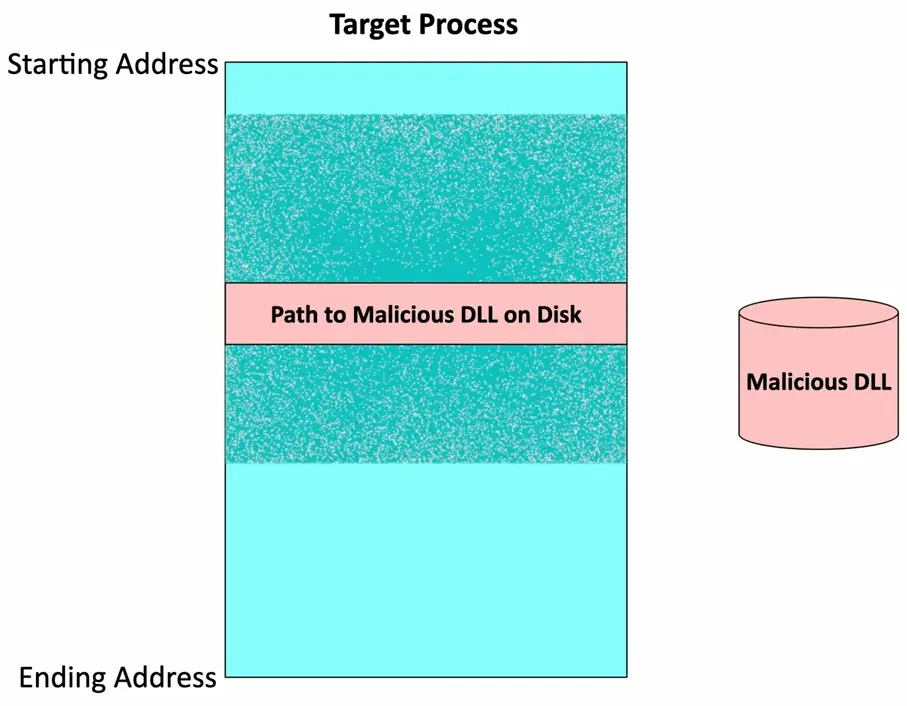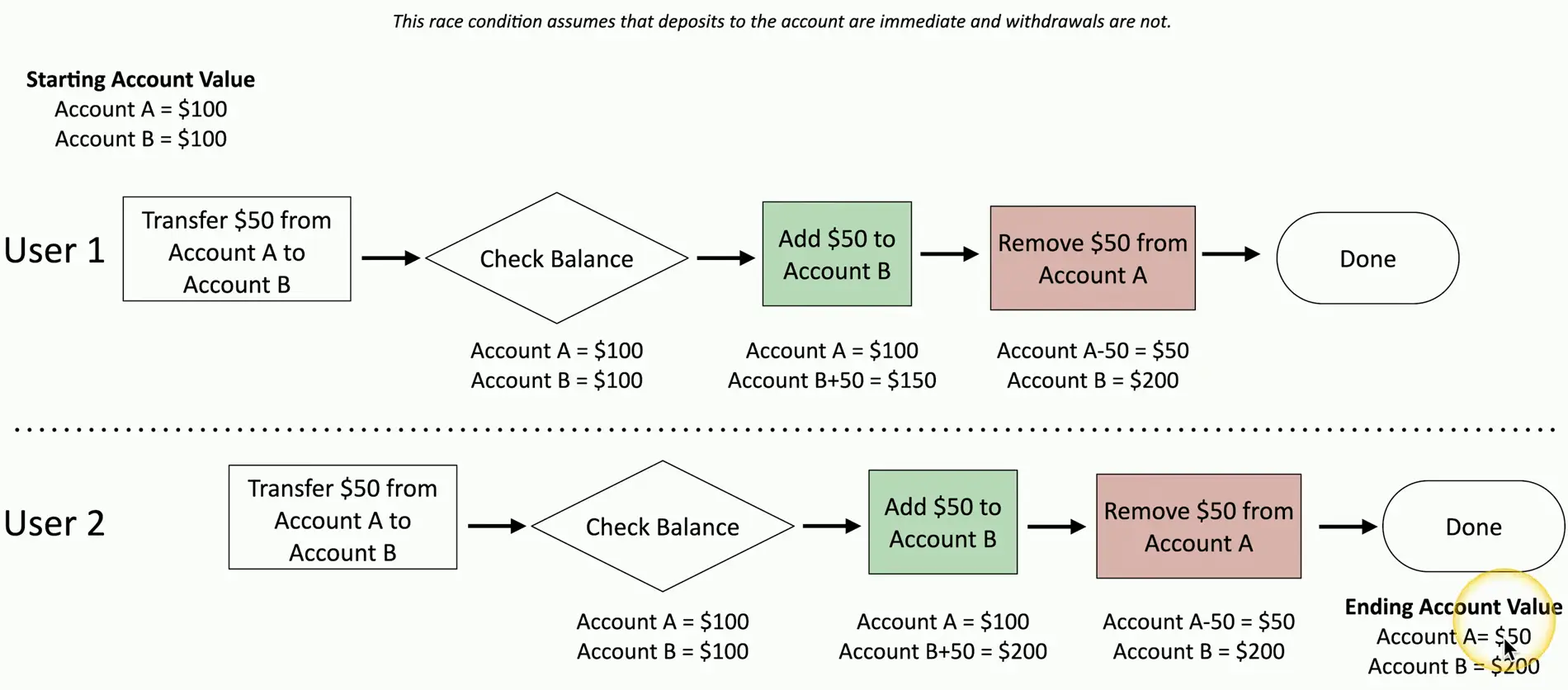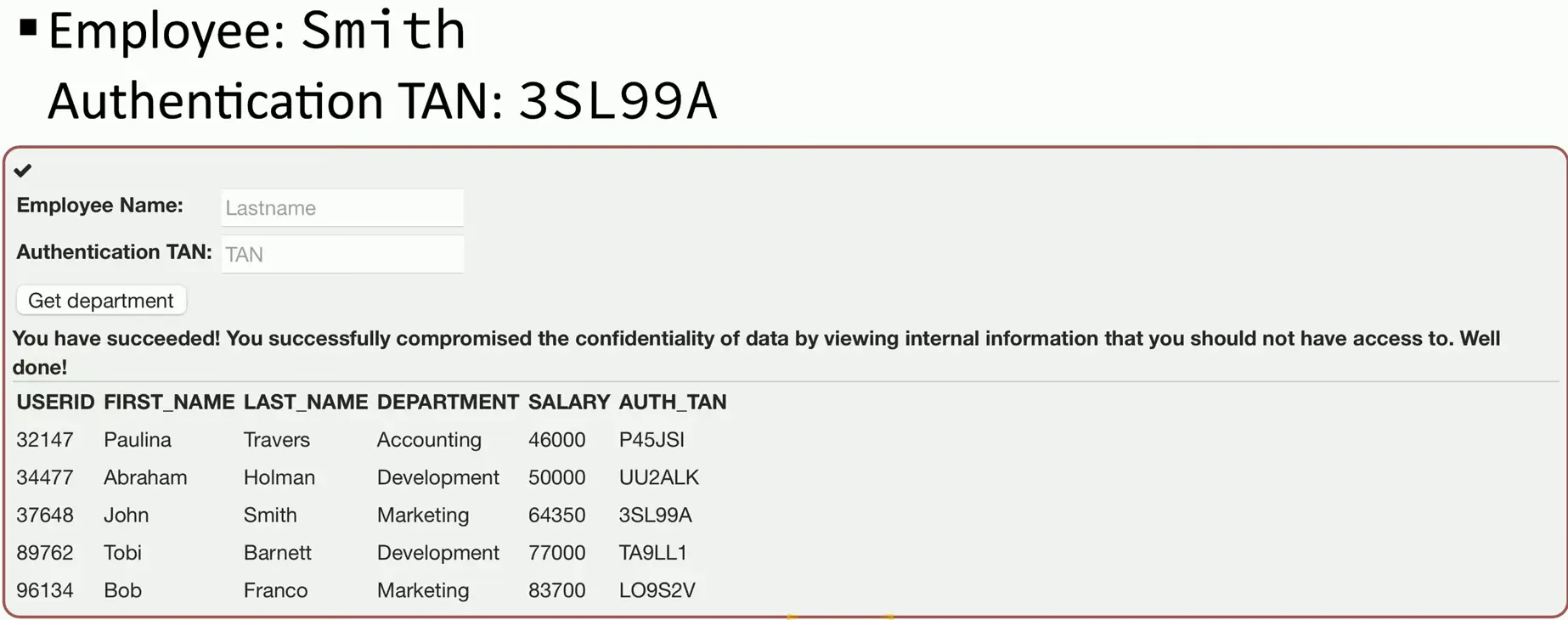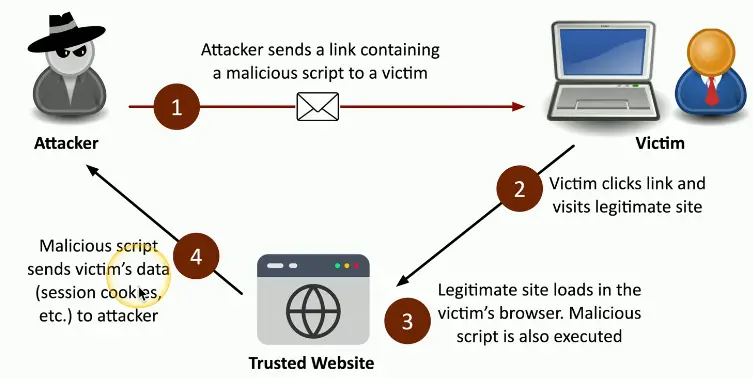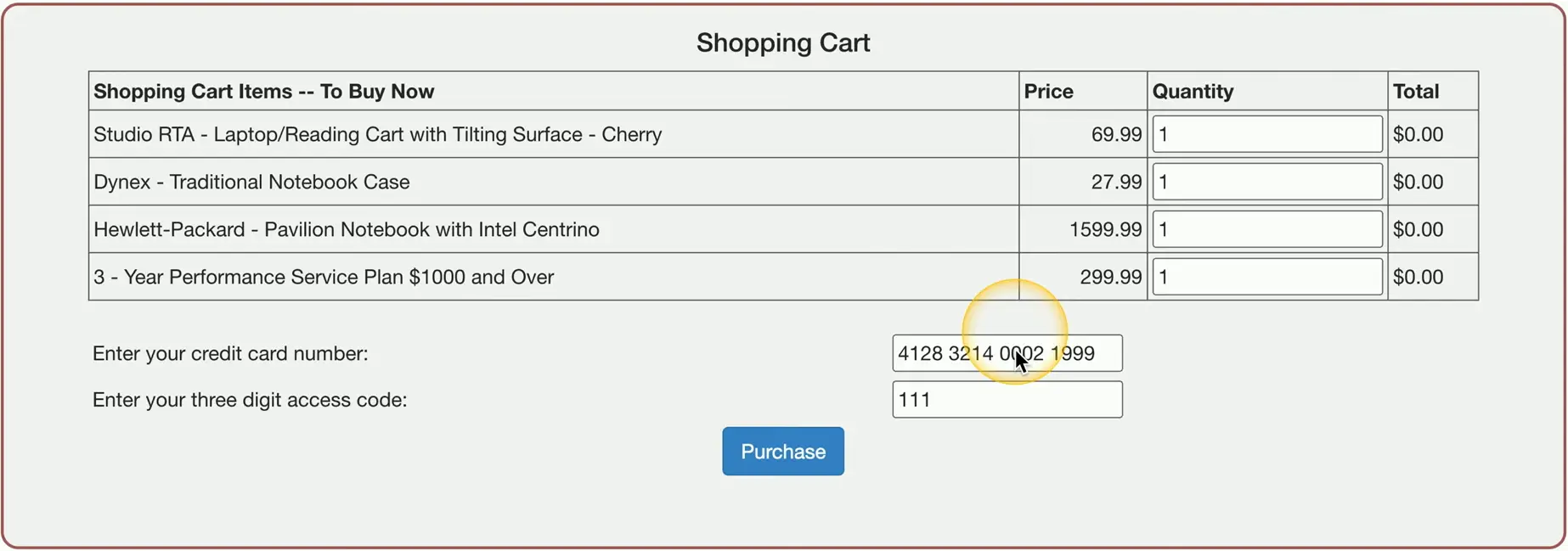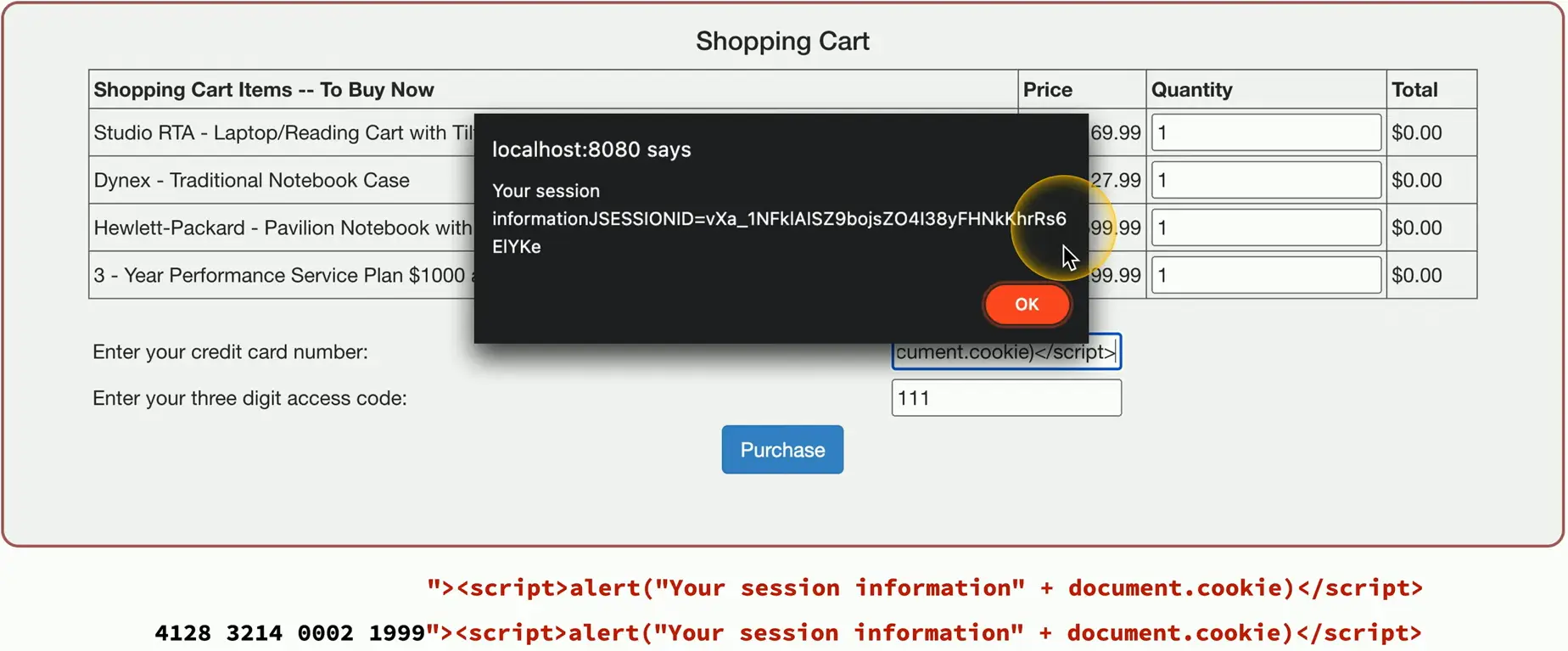Types of Vulnerabilities
Finding Malware
Malware runs in memory
- Memory forensics can find the malicious code
Memory contains running processes
- DLLs (Dynamic Link Libraries)
- Threads
- Buffers
- Memory management functions
- And much more
Malware is hidden somewhere
- Malware runs in its own process
- Malware injects itself into a legitimate process
Memory Injection
Add code into the memory of an existing process
- Hide malware inside the process
Get access to the data in that process
- And the same rights and permissions
- Perform a privilege escalation
DLL Injection
Dynamic-Link Library
- A Windows library containing code and data
- Many applications can use this library
Attackers inject a path to a malicious DLL
- Runs as part of the target process
One of the most popular memory injection methods
- Relatively easy to implement
Buffer Overflows
Overwriting a buffer of memory
- Spills over into other memory areas
Developers need to perform bounds checking
- The attackers spend a lot of time looking for openings
Not a simple exploit
- Takes time to avoid crashing things
- Takes time to make it do what you want
A really useful buffer overflow is repeatable
- Which means that a system can be compromised
Race Conditions
Race Condition
A programming conundrum
- Sometimes, things happen at the same time
- This can be bad if you’ve not planned for it
Time-of-check to time-of-use attack (TOCTOU)
- Check the system
- When do you use the results of your last check?
- Something might happen between the check and the use
Race Condition Example
Race Conditions can cause big problems
January 2004 — Mars rover “Spirit”
- Reboot when a problem is identified
- Problem is with the file system, so reboot because of the file system problem
- Reboot loop was the result
Pwn2Own Vancouver 2023 — Tesla Model 3
- TOCTOU attack against the Tesla infotainment using Bluetooth
- Elevated privileges to root
- Earned $100,000 US prize, and they keep the Tesla
Malicious Updates
Software Updates
Always keep your operating system and applications updated
- Updates often include bug fixes and security patches
This process has its own security concerns
- Note every update is equally secure
Follow best practices
- Always have a known-good backup
- Install from trusted sources
- Did I mention the backup?
Downloading and updating
Install updates from a downloaded file
- Always consider your actions
- Every installation could potentially be malicious
Confirm the source
- A random pop-up during web browsing may not be legitimate
Visit the developer’s site directly
- Don’t trust a random update button or random downloaded file
Many OSes will only allow signed apps
- Don’t disable your security controls
Automatic Updates
The app updates itself
- Often includes security checks/digital signatures
Relatively trustworthy
- Comes directly from the developer
SolarWinds Orion supply chain attack
- Reported in December 2025
- Attackers gained access to the SolarWinds development system
- Added their own malicious code to the updates
- Gained access to hundreds of government agencies and companies
Operating System Vulnerabilities
Operating Systems
A foundational computing platform
- Everyone has an OS
- This makes the OS a very big target
Remarkably complex
- Millions of lines of code
- More code means more opportunities for a security issues
The vulnerabilities are already in there
- We’ve just not found them yet
A month OS updates
A normal month of Windows updates
- Patch Tuesday — 2nd Tuesday of each month
- Other companies have similar schedules
May 9, 2023 — Nearly 50 security patches
- 8 Elevation of Privilege Vulnerabilities
- 4 Security Feature Bypass Vulnerabilities
- 12 Remote Code Execution Vulnerabilities
- 8 Information Disclosure Vulnerabilities
- 5 Denial of Service Vulnerabilities
- 1 Spoofing Vulnerability
Checkout Microsoft Security Center for latest patches and updates: https://msrc.microsoft.com/
Best Practices for OS Vulnerabilities
Always update
- Monthly or on-demand updates
- It’s a race between you and the attackers
May require testing before deployment
- A patch might break something else
May require a reboot
- Save all data
Have a fallback plan
- Where’s that backup?
SQL Injection
Code Injection
Code Injection
- Adding your own information into a data stream
Enabled because of bad programming
- The application should properly handle input and output
So many data types
- HTML, SQL, XML, LDAP
SQL Injection
SQL — Structured Query Language
- The most common relational database management system language
SQL injection (SQLi)
- Put your own SQL requests into an existing application
- Your application shouldn’t allow this
Can often be executed in a web browser
- Inject in a form or field
Building a SQL Injection
An example of website code:
How this looks to the SQL database
Add more information to the query (SQLi):
This could be very bad
- View all database information, delete database information, add users, denial of service, etc.
SQL Injection Demonstration
Source: https://owasp.org/www-project-webgoat/
Cross-site Scripting
XSS
XSS
- Cascading Style Sheets (CSS) are something else entirely
Originally called cross-site because of browser security flaws
- Information from one site could be shared with another
One of the most common web app vulnerabilities
- Takes advantage of the trust a user has for a site
- Complex and varied
XSS commonly uses JavaScript
- Do you allow scripts? Me too.
Non-persistent (reflected) XSS Attack
Website allows scripts to run in user input
- Search box is a common source
Attacker emails a link that takes advantage of this vulnerability
- Runs a script that sends credentials/session IDs/Cookies to the attacker
Script embedded in the URL executes in the victim’s browser
- As if it came from the server
Attacker uses credentials/session IDs/cookies to steal victim’s information without their knowledge
- Very sneaky
Persistent (stored) XSS Attack
Attacker posts a message to a social media
- Includes the malicious payload
It’s now “persistent”
- Everyone gets the payload
No specific target
- All viewers to the page
For social networking, this can spread quickly
- Everyone who views the message can have it posted to their page
- Where someone else can view it and propagate it further
Hacking a Subaru
June 2017, Aaron Guzman
- Security Researcher
When authenticating with Subaru, users get a token
- This token never expires (bad!)
A valid token allowed any service request
- Even adding your email address to someone else’s account
- Now you have full access to someone else’s car
Web front-end included an XSS vulnerability
- A user clicks a malicious link, and you have their token
Protecting Against XSS
Be careful when clicking untrusted links
- Never blindly click in your email inbox, Never.
Consider disabling JavaScript
- Or control with an extension
- This offers limited protection
Keep your browser and applications updated
- Avoid the nasty browser vulnerabilities
Validate input
- Don’t allow users to add their own scripts to an input field
Hardware Vulnerabilities
We are surrounded by hardware devices
- Many don’t have an accessible OS
These devices are potential security issues
- A perfect entry point for an attack
Everything is connecting to the network
- Light bulbs, garage doors, refrigerators, door locks
- IoT is everywhere
The security landscape has grown
- Time to change your approach
Firmware
The software inside the hardware
- The OS of the hardware device
Vendors are the only ones who can fix their hardware
- Assuming they know about the problem
- And care about fixing it
Trane Comfortlink II thermostats
- Control the temperature from your phone
- Trane notified of three vulnerabilities in April 2014
- Two patched in April 2015, one in January 2016
End-of-life
End of life (EOL)
- Manufacturer stops selling a product
- May continue supporting the product
- Important for security patches and updates
End of service life (EOSL)
- Manufacturer stops selling a product
- Support is no longer available for the product
- No ongoing security patches or updates
- May have a premium-cost support option
Technology EOSL is a significant concern
- Security patches are part of normal operation
Legacy Platforms
Some devices remain installed for a long time
- Perhaps too long
Legacy devices
- Older OSes, applications, middleware
May be running end-of-life software
- The risk need to be compared to the return
May require additional security protections
- Additional firewall rules
- IPS signatures for older OSes
Virtualization Vulnerabilities
Virtualization Security
Quite different from non-virtual machines
- Can appear anywhere
Quantity of resources vary between VMs
- CPU, memory, storage
Many similarities to physical machines
- Complexity adds opportunity for the attackers
Virtualization vulnerabilities
- Local privilege escalations
- Command injection
- Information disclosure
VM escape protection
The virtual machine self-contained
- There’s no way out
- Or is there?
Virtual machine escape
- Break out of the VM and interact with the host OS or hardware
Once you escape the VM, you have great control
- Control the host and control other guests VMs
This would be a huge exploit
- Full control of the virtual world
Escaping the VM
March 2017 — Pwn2Own competition
- Hacking contest
- You pwn it, you own it — along with some cash
JavaScript engine bug in Microsoft Edge
- Code execution in the Edge sandbox
Windows 10 kernel bug
- Compromise the guest OS
Hardware simulation bug in VMware
- Escape to the host
Patches were released soon afterward
Resource Reuse
The hypervisor manages the relationship between physical and virtual resources
- Available RAM, storage space, CPU availability, etc.
These resources can be reused between VMs
- Hypervisor host with 4 GB of RAM
- Supports three VMs with 2 GB of RAM each
- RAM is allocated and shared between VMs
Data can inadvertently be shared between VMs
- Time to update the memory management features
- Security patches can mitigate the risk
Cloud Specific Vulnerabilities
Security in the Cloud
Cloud adoption has been nearly universal
- It’s difficult to find a company NOT using the cloud
We have put sensitive data in the cloud
- The attackers would like this data
We are not putting in the right protections
- 76% of organizations aren’t using MFA for management of console users
Simple best-practices aren’t being used
- 63% of code in production is unpatched
- Vulnerabilities rated high or critical (Common Vulnerability Scoring System - CVSS >= 7.0)
Attack the service
Denial of Service (DoS)
- A fundamental attack type
Authentication bypass
- Take advantage of weak or faulty authentication
Directory transversal
- Faulty contiguration put data at risk
Remote code execution
- Take advantage of unpatched systems
Attack the application
Web application attacks have increased
- Log4j and Spring Cloud Function
- Easy to exploit, rewards are extensive
Cross-site scripting
- Take advantage of poor input validation
Out of bound write
- Write to unauthorized memory areas
- Data corruption, crashing, or code execution
SQL injection
- Get direct access to a database
Supply Chain Vulnerabilities
Supply Chain Risk
The chain contains many moving parts
- Raw materials, suppliers, manufacturers, distributors, customers, consumers
Attackers can infect any step along the way
- Infect different parts of the chain without suspicion
- People trust their suppliers
One exploit can infect the entire chain
- There’s a lot at stake
Service Providers
You can control your own security posture
- You can’t always control a service provider
Service providers often have access to internal services
- An opportunity for the attacker
Many types of providers
- Network, utility, office cleaning, payroll/accounting, cloud services, system administration, etc.
Consider ongoing security audits of all providers
- Should be included with the contract
Target Service Provider Attack
Target Corp. breach — November 2013
- 40 million credit cards stolen
Heating and AC firm in Pennsylvania war infected
- Malware delivered in an email
- VPN credentials for HVAC techs were stolen
HVAC vendor was the supplier
- Attackers used a wide-open Target network to infect every cash register at 1800 stores
Hardware Providers
Can you trust your new server/router/switch/firewall/software?
- Supply chain cybersecurity
Use a small supplier base
- Tighter control of vendors
Strict controls over policies and procedures
- Ensure proper security is in place
Security should be part of the overall design
- There’s a limit to trust
Cisco or not Cisco?
All network traffic flows
- A perfect visibility and pivot point
July 2022 — DHS arrests reseller CEO
- Sold more than $1 billion of counterfeit Cisco products
- Created over 30 different companies
- Had been selling these since 2013
Knock-offs made in China
- Sold as authentic Cisco products
- Until they started breaking and catching on fire
Software providers
Trust is a foundation of security
- Every software installation questions our trust
Initial installation
- Digital signature should be confirmed during installation
Updates and patches
- Some software updates are automatic
- How secure are the updates?
Open source is not immune
- Compromising the source code itself
SolarWinds Supply Chain Attack
SolarWinds Orion
- Used by 18000 customers
- Including Fortune 500 and US Federal Government
Software updates compromised in March and June 2020
- Upgrades to existing installations
- Not detected until December 2020
Additional breaches took advantage of the exploit
- Microsoft, Cisco, Intel, Deloitte
- Pentagon, Homeland Security, State Department, Department of Energy, National Nuclear Security Administration, Treasury
Misconfiguration Vulnerabilities
Open Permissions
Very easy to leave a door open
- The hackers will always find it
Increasingly common with cloud storage
- Statistical chance of finding an open permission
June 2017–14 million Verizon records exposed
- Third-party left an Amazon S3 data repository open
- Researcher found the data before anyone else
Many, Many other examples
- Secure your permissions!
Unsecured Admin Accounts
The Linux root account
- The Windows Administrator or superuser account
Can be misconfiguration
- Intentionally configuring an easy-to-hack password
- 123456, ninja, football
Disable direct login to the root account
- Use the
suorsudooption
Protect accounts with root or administrator access
- There should not be a lot of these
Insecure Protocols
Some protocols aren’t encrypted
- All traffic sent in the clear
- Telnet, FTP, SMTP, IMAP
Verify with a packet capture
- View everything sent over the network
Use the encrypted versions
- SSH, SFTP, IMAPS
Default Settings
Every application and network device has a default login
- Not all of these are ever changed
Mirai Botnet
- Take advantage of default configurations
- Takes over Internet of Things (IoT) devices
- 60+ default configurations
- Camera, routers, doorbells, garage door openers, etc.
Mirai released as open-source software
- There’s a lot more where that came from
Open Ports and Services
Services will open ports
- It’s important to manage access
Often managed with a firewall
- Manage traffic flows
- Allow or deny based on port number or application
Firewall rulesets can be complex
- It’s easy to make mistake
Always test and audit
- Double and triple check
Mobile Device Vulnerabilities
Mobile Device Security
Challenging to secure
- Often need additional security policies and systems
Relatively small
- Can be almost invisible
Almost always in motion
- You never know where it might be
Packed with sensitive data
- Personal and organizational
Constantly connected to the Internet
- Nothing bad happens on the Internet
Jailbreaking/Rooting
Mobile devices are purpose built systems
- You don’t have access to the OS
Gaining access
- Android — Rooting
- Apple iOS — Jailbreaking
Install custom firmware
- Replaces the existing OS
Uncontrolled access
- Circumvent security features
- The MDM (Mobile Device Management) becomes relatively useless
Sideloading
Malicious apps can be a significant security concern
- One Trojan horse can create a data breach
Manage installation sources
- The global or local app store
Sideloading circumvents security
- Apps can be installed manually without using an app store
- Again, your MDM becomes relatively useless
Zero-day Vulnerabilities
Vulnerabilities
Many applications have vulnerabilities
- We have just not found them yet
Someone is working hard to find the next big vulnerability
- The good guys share these with developers
Attackers keep these yet-to-be-discovered holes to themselves
- They want to use these vulnerabilities for personal gain
Zero-day Attacks
Attackers search for unknown vulnerabilities
- They create exploits against these vulnerabilities
The vendor has no idea the vulnerability exists
- They don’t have a fix for an unknown problem
Zero-day attacks
- An attack without a patch or method of mitigation
- A race to exploit the vulnerability or create a patch
- Difficult to defend against the unknown
Common Vulnerabilities and Exposure (CVE)
Zero-day Attacks in the wild
April 2023 — Chrome zero-day
- Memory corruption, sandbox escape
May 2023 — Microsoft zero-day patch
- Secure boot zero-day vulnerability
- Attackers can run UEFI-level self-signed code
May 2023 — Apple iOS and iPadOS zero-days
- Three zero-day attacks
- Sandbox escape, disclosure of sensitive information, arbitrary code execution
- Active exploitation

